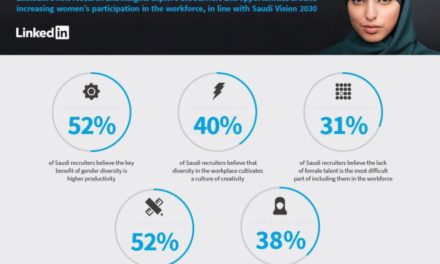
Korn Ferry Study Reveals Company Payrolls in KSA Could Soar Long-Term

Salaries for highly skilled workers could boom as talent shortages take hold across EMEA, according to The Salary Surge, a new study* by Korn Ferry (NYSE: KFY) as part of an ongoing Future of Work research project.
Left unchecked, the salary surge could add more than $2.5 trillion to annual payrolls by 2030 in 20 leading economic markets analysed, $593 billion in the EMEA region alone. This potential salary surge is the direct the result of a shortage of an estimated 85 million highly skilled workers required for companies to succeed in the new digital economy.
In the UAE, while overall wage increases are just keeping pace with inflation, salaries for in-demand workers could add as much as $5.9 billion to the total national payroll by 2030, a 9 percent increase. Businesses in the Kingdom of Saudi Arabia could see a wage surge of more than 17 percent, adding a potential $33.6 billion to national payrolls.
“The new era of work is one of scarcity in abundance: there are plenty of people, but not enough with the skills their organizations will need to survive,” said Jonathan Holmes, Managing Director, Korn Ferry MENA. “With The Salary Surge, we are putting a price tag on the deficit of highly skilled workers that threatens future profitability and business models of companies as well as national economic development and diversification strategies in the UAE and KSA. We all face the reality that salaries for in-demand workers will skyrocket if companies choose to compete for the best and brightest on salary alone.”
Korn Ferry’s Salary Surge study estimates the impact of the global talent shortage (identified in Korn Ferry’s recent Global Talent Crunch study) on payrolls in 20 major global economies at three milestones: 2020, 2025 and 2030, and across three sectors: financial and business services; technology, media and telecommunications (TMT); and manufacturing. It measures how much more organizations could be forced to pay workers, above normal inflation increases.
The study reveals the significant impact the salary surge could have on KSA and the UAE:
In KSA, the TMT sector could be hardest hit, with a potential wage premium $2.4 billion by 2030. That’s followed by the Manufacturing sector which faces a potential overall payroll increase of $2.1 billion.
The TMT sector also faces the greatest challenges in the UAE, with a potential wage premium of $1.124 billion, followed by Financial and Business Services at $612 million.
KSA ranks number eight out of 20 economies in individual wage premiums for highly skilled workers, with potential individual salaries rising by $10,700 per worker by 2030. That’s 21 percent higher salary impact per worker than the EMEA average.
“This is a challenge facing both corporate and government leaders planning for economic success in the new economy. In the public sector, the longer-term solution starts in the education sector and how we are preparing our students with new skills more adaptable to the future of work,” said Harish Bhatia, Regional Director, Korn Ferry Products MENA. “In the private sector, business leaders need to reimagine all aspects of talent management, employee engagement and reward schemes to better position them to retain top talent at lower wage premiums to protect profitability and business models.”
While the impact close to home is significant, economies across the EMEA region face even greater risk:
Germany is the worst affected, facing worker shortfalls that equate to more than one in six highly skilled workers. This could result in a potential wage premium of nearly $176 billion by 2030.
While the United Kingdom and France can expect a better short-term outlook, by 2030 the U.K.’s wage premium may be equivalent to 5 percent of its 2017 GDP* and France’s may reach 4 percent of its 2017 GDP*.
In financial and business services, the U.K. and Germany, homes to the world’s leading financial centres, are amongst the economies with the highest wage premiums: the U.K. faces a potential wage increase of more than $27 billion in this sector by 2030, and Germany almost double that at close to $44 billion.
In Germany, manufacturing could stall under the impact of an additional wage bill of more than $20 billion by 2030.
By 2030, the average pay premium (what employers could have to pay over and above the amount that salaries would rise over time due to normal inflation) across the region per worker is $8,500 per year: Germany could expect to pay an extra $16,000 per year by 2030; the Netherlands $10,800; and the U.K. $8,100.
Globally the talent crunch could add $2.5 trillion to company payrolls annually, revealing the huge impact the salary surge could have at a country level:
U.S. and Japanese companies can expect to pay the most: the U.S. faces a wage premium of more than $531 billion by 2030; Japan is predicted to pay an additional $468 billion by 2030.
Smaller markets with limited workforces are likely to feel the most pressure. By 2030, Singapore and Hong Kong could expect salary premiums equivalent to more than 10 percent of their respective 2017 GDPs*.
By 2030, China could see an additional wage bill of more than $342 billion.
India is the only economy that can expect to avoid upward spiralling wages, as unlike any other country in the study it will have a highly skilled talent surplus at each milestone.
“Buying in talent from the market is unsustainable. Instead, companies across EMEA must focus on engaging and reskilling their current workers,” said Vijay Gandhi, Korn Ferry Products EMEA. “With existing highly skilled workers, leaders must focus on what really drives retention. We know that employees who have the opportunity for career development, benefit from inspiring leadership and feel their work has purpose are more likely to stay at an organization, and – crucially – will be more engaged and productive. Companies need to identify the talent of tomorrow and help them achieve their potential. Reward programs need to shift from short-term high fixed pay to retention pay over long-term to earn better ROI from skilled talent today in workforce. Extending the long-term retention program not only to Executives but to high potential staff in the organisation can make a difference to address the Talent crunch”
*GDP figures based on 2017 IMF estimates





























